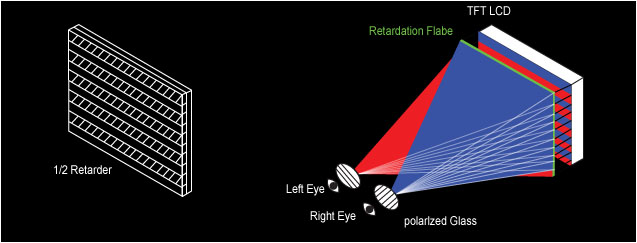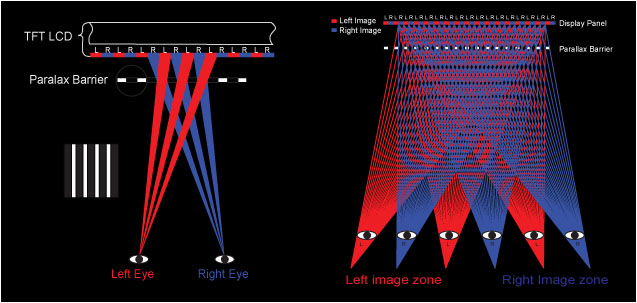Stereoscopic viewing and displays
A stereoscopic 3D Display can create the perception of depth on a flat screen by providing to each eye of a viewer a slightly different image of the same object.The difference is the same that we naturally perceive from our left and right eye when viewing a real object.
Pavonine Inc. is offering diplays that achieve this with the help of polarized glasses or also totally glasses-free!
An auto-stereoscopic screen makes use of a spatial imaging system that allows enjoyment of steresocopic images without wearing speical glasses such as shutter glasses or polarized glasses. The C-Series uses 3D electro potic technology and imaging treatment technology, creating the illusion of third demensions beyond the confines of the screen's physical space.
A Parallax Barrier is an electro optic panel with fine. vertical slits that are placed at a regular spacing. This 3D electro optic panel is attached to the surface of a LCD, and separates the light pathway of spatial images into images for left and right eyes so that users can perceive dimension. The C-Series makes the transformathon of 2D/3D possible with a push of a button, by applying an electronic parallax barrier.
The separathon of images for our G-Series is achieved by the use of polarising micro-optics, thet split a single display into two different polarised views, which are viewed correctly by left and right eyes when the viewer uses accordingly polarized glasses. Also here the display can easlily be switched from 2D to 3D.
Our Dimen 3D LCD dispalys support all stereo imaging formats that are currently used; Interlaced, Frame/Field Sequential, Side-Field, and Sub-Field. These various forms of spatial images can be reproduced without any restrictions.
· Micropolarizer technology
- Changes polarization of an LCD display on a line by line basis
- Periodic array of small polarizers that alternate between perpendicular polarizing states
- Usually left eye image on even lines, right eye image on odd lines
- Need for passive polarized glasses
- Requires composite image that contains both left and right eye information on a line-by-line basis

· Advantages of micropolarizer based technology
- High resolution
- Content easy to produce
- Freedom of movement
- Multi-user capable
- No dependence of refresh rates, no flickering
- 2D-3D switchable
- Easy to produce
- Disadvantages
- Need for polarized glasses

· Parallax-barrier
- Consists of fine vertical slits in an opaque medium
- Barrier placed in front of image with left and right image presented in vertical slits
- If frequency of image slits and barrier slits fit and viewer is in required distance from barrier, a left and right images can be
seen by left and right eye respectively
- No need for polarized glasses
· Advantages of Parallax-technology
- High resolution
- Content is available, easy to produce
- No glasses necessary
- Easy to produce
- No dependence of refresh rates, no flickering
- 2D-3D switchable
· Disadvantage
- Limited number of sweet spots, limited freedom of movement
